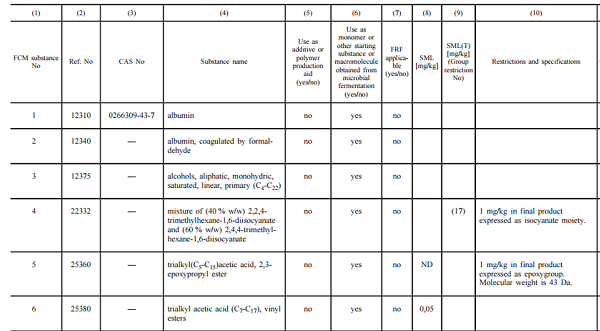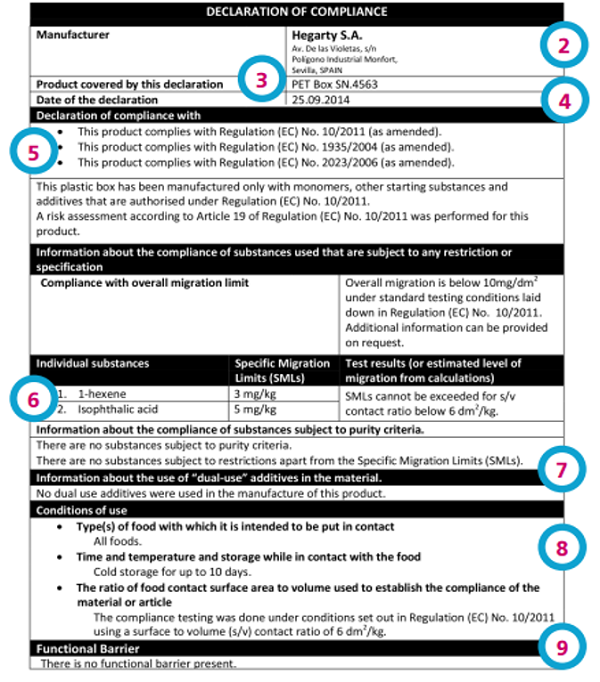How to Comply with Food Contact Regulations in EU
Little Pro on 2017-02-14
EU's definition of food contact materials is very broad. It includes both food package materials and any other materials and articles (i.e, coffee machine, some food processing machine) that are expected to come into contact with food under normal and foreseeable use conditions. Both chemical companies who supply food contact materials (including food contact additives) and food packaging or food companies need to comply EU's food contact regulation. In this article, we will give an introduction to how to comply with food contact regulations in EU with a focus on EU's regulation for plastic food contact materials. Sample declaration of compliance (DoC) for food contact materials is also given.
Overview of EU's Food Contact Legislation
There are plenty of food contact regulations in EU. Luckily, you only need to comply with 2 main ones and some measures specific to your products (see table below).
| Regulation | Description |
|---|---|
|
Regulation (EC) No 1935/2004 |
It is EU's framework regulation and sets out general requirements for all food contact materials (FCMs):
|
|
Regulation (EC) No 2023/2006 on GMP |
|
|
Specific Measures for Materials
|
Note: For FCMs with no specific EU measures, Member States may adopt their own national provisions on food contact materials. |
|
Specific Measures for Substances
|
|
For some types of food contact materials (i.e, coatings, adhesives, and paper) for which there is no specific measures at EU level, a majority of EU Member States have set their own national provisions. You also need to comply with those national measures. More info can be found below.
In the rest of this article, we will use the Regulation (EU) No 10/2011(also known as plastics regulation) as an example to show you how to comply with specific measures.
Regulation (EU) No 10/2011 on Plastic Materials and Articles
The plastics regulation is the most comprehensive specific EU measure for plastic food contact materials. It sets out rules concerning the following aspects:
- It sets out a Union list of authorised substances (monomer, starting substances, additivies, etc) that can be used in the manufacture of plastic layers of food contact materials.
- It sets specific migration limits (SML) and restriction conditions for some substances on the positive list.
- It sets maximum overall migration limits (OML) for the plastic food contact materials to be 60mg/kg food.
- It sets out the compliance testing requirements (for example, food simulants, test duration & temperature).
- It sets out a declaration of compliance (DoC) requirement.
Union List of Authorised Substances for Plastics
The annex I to the plastics regulation is a positive list of authorised substances that can be used in the manufacture of the plastic layers of food contact plastic materials and articles (see picture below). The list covers monomers, starting substances, additives, and polymer production aids.
Restriction, specification and specific migration limits are also listed if available. The complete list can be downloaded here.

Note 1: The Union list does not include authorized solvents and colorants, and substances only used to manufacture adhesives, coatings and printing inks. Substances on provisional list may also be used if compliant with national legislation.
Note 2: A listed substance must also comply with restriction and specification set out in column 10 (i.e, "not to be used for articles in contact with fatty foods"). A food contact material or article made from listed substances must comply with specific migration limits (SML) given in column 8 and 9.
Read more about the positive list of food contact substances and additives in EU
Compliance Testing - Migration Testing
The migration of a hazardous substance into the food stuff is the main safety concern for food contact materials. The compliance of FCMs can be verified by migration testing. The plastics regulation requires that finished food contact materials and articles comply with both the specific migration limits (SML) and the overall migration limits (OML).
- Specific migration limits (SML): the amount of a specific substance that can migrate from FCM into the food stuff. Usually expressed in mg/kg. This can usually be found in column 8 and 9 in the Union list.
- Overall migration limits (OML) : the total amount of all chemical substances that can migrate from FCM into the food stuff. Usually expressed as mg/kg food or per food contact surface area (mg/dm2).
Migration testing is usually done by using various food simulants (for example, 10% ethanol for alcohols, 3% acetic acid for acidic food). Testing temperature and duration also vary depending on food package use conditions.
Declaration of Compliance (DoC)
If you are a manufacturer or supplier of a food contact material (including additive), it is very important to reassure your customer that your product complies with the applicable EU and national legislation. The plastics regulation requires that a written declaration of compliance (DoC) be provided for finished plastic materials and articles, products from intermediate stages of their manufacturing as well as for the substances intended for the manufacturing of those materials and articles (excluding retail stage).
Each manufacturer has to declare their compliance under his responsibility depending on his role in the supply chain and communicate his DoC to customers (see below example).
- Producer of a monomer or additive: Ensuring that the substance is authorised for use and complies with the restriction and specifications listed in the Union list.
- Producer of an intermediate plastic product: Ensuring that all monomers and additives are authorised and indicating the conditions of use under which migration limits can be complied with.
- Manufacturer of final food contact material or article: Indicating the conditions of use under which restrictions and migration limits can be complied with. Usually migration testing is done on finished food contact materials and articles to verify compliance.
Requirements on Declaration of Compliance (DoC)
The plastics regulation further requires that the written declaration of compliance for food contact materials contain the following information.
- the identity and address of the business operator issuing the DoC;
- the identity and address of the manufacturer or importer;
- the identity of the food contact materials, intermediate product or substance;
- the date of the declaration;
- confirmation that the plastic materials or articles, products from intermediate stages of manufacture or the substances meet relevant requirements laid down in EU's framework regulation;
- information about the compliance of substances subject to any restriction or specification;
- specifications on the use of the material or article, such as: (i) type or types of food with which it is intended to be put in contact; (ii) time and temperature of treatment and storage in contact with the food; (iii) ratio of food contact surface area to volume used to establish the compliance of the material or article;
- when a functional barrier is used in a multi-layer material or article, the confirmation that the material or article complies with the requirements of Article 13(2), (3) and (4) or Article 14(2) and (3) of this Regulation.
Sample Declaration of Compliance (DoC)
The picture below is a sample of declaration of compliance (DoC) for food contact materials given by the Food Safety Authority of Ireland and it has included all required info. Click here to download the sample DoC in pdf format. It can be easily modified for use for other types of food contact materials.

Summary
To demonstrate your compliance with EU food contact legislation, you need to do the following things:
- Manufacture your food contact material or article in accordance with GMP.
- Only use authorised substances to manufacture food contact materials if there is a positive list for the type of materials (i.e, plastics).
- Carry out migration testing to ensure that SMLs and OMLs are not exceeded.
- Comply with other specification requirements and restrictions given in specific measures (i.e, food types).
- Issue declaration of compliance (DOC) to your customers.
Reference
- Introduction to food contact legislation in EU
- Regulation (EC) No 1935/2004 on materials and articles intended to come into contact with food
- Regulation (EC) No 2023/2006 on good manufacturing practice for materials and articles intended to come into contact with food
- Regulation (EU) No 10/2011 on plastic materials and articles intended to come into contact with food
- Union Guidelines on Regulation (EU) No 10/2011 on plastic materials and articles intended to come into contact with food
Having Questions?
We do not provide consultancy services. If you have questions or need any help, please contact our sponsor. You may also find an expert in CSP business directory below. If you are a consultant, you may get yourself listed in CSP business directory (free) or sponsor this page to leave your contact info on this page..

Tags: Topics - Food Contact, Food Contact Regulations
